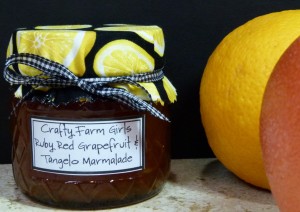
I don’t know if you’ve noticed, but ruby red grapefruits must have just come into season, because they are beautiful at the grocery stores around here. I decided I had to make some marmalade with them, as my marmalade supply for my Free Range Friday’s (when I sell my eggs and other things) is almost gone. They also had some lovely tangelos, so I decided to combine the two, more grapefruit and an accent of tangelo.
Now I’ve made marmalade all kinds of different ways, but I’ve decided the best way, although by far the most time-consuming, is to slice the thinly peeled rind, section the fruits, and put all of the leftovers in cheesecloth for the flavor and the natural pectin, but not to be a part of the actual marmalade. Lots of recipes call for chopping the entire citrus — pith, membranes and all, only removing the seeds. I’ve done it like this, and it is certainly easier, but if you don’t eat it when you’re eating the fruit normally, why would you want it in your marmalade?

Wash the fruit carefully.

Section the fruit from the membrane and roughly chop. Save the membrane.
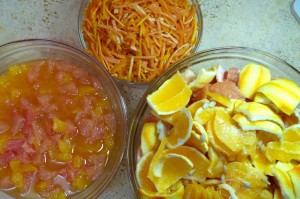
Thinly peel the rind off the fruit and slice thinly. Section the fruit by cutting between the membranes, remove seeds and roughly chop. Save all of the scraps, the white pith under the skin, the membranes holding the sections together, even the seeds. This will be used for the natural pectin in citrus to gel the marmalade.

Fruit, rind, sugar and water is all that goes into marmalade. The ratio is 1:1:1; the weight of the fruit and rind together (in my case I had 3 pounds 4 oz. of rind and fruit), so I added 3 pounds 4 oz. sugar and 3 pounds 4 oz. of water.

Stir to combine the ingredients and turn the heat on medium.
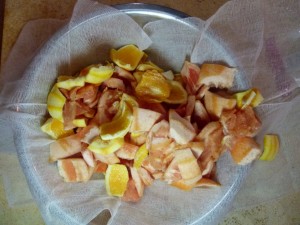
Put all of the citrus "scraps" into a double layer of cheesecloth. I had so much I laid the cheesecloth into a bowl and then poured the fruit in
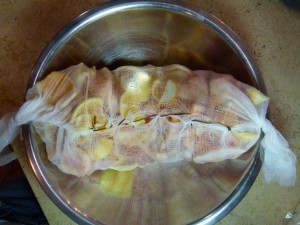
Since I had so much, I decided the best way to do this was to roughly sew up the middle section of the pectin bag. To just gather the ends would have had the scraps falling out of the sides.
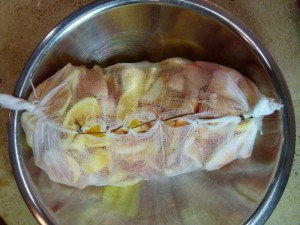
Twist the ends of the cheesecloth bag tightly and tie a knot on each end with kitchen twine. Trim any excess cheesecloth from the ends past the knot.

Stick the scrap bag into the pot. Try to squeeze it over onto one side and push the fruit away from it as you are inserting it into the pot.
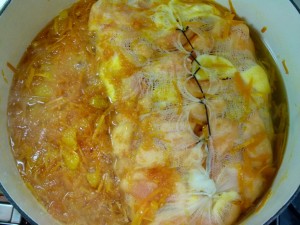
Bring mixture to a strong boil on high heat, with lid off, until the peels are soft and cooked through, about 20-25 minutes..

Turn the flame off under the marmalade, remove the pectin bag, letting it drain as much as possible. Place bag in a large work bowl and allow to cool. Once it's cool enough to handle, lift it above the work bowl and tightly squeeze the bag, starting at the top, allowing the remaining juices and pectic to flow down into the work bowl. Discard the pectin bag when done.
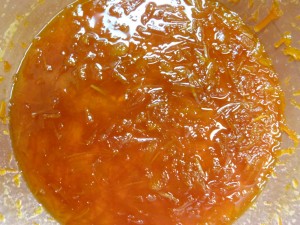
Place the pectin you've gotten from the bag back into the marmalade mixture, return to a medium-high heat and stir often while boiling until it reaches a temperature of 119-220 degrees on a candy thermometer. ladle finished marmalade into clean, sterilized jars, wipe rims clean with a damp cloth, place sterilized lids on, and process in a hot water bath for ten minutes.

3 pounds 4 ounces of rind and fruit, lots of time and effort, and I yielded 8-half pint jars of finished marmalade, But I feel that the flavor of the marmalade made in this traditional fashion, without all of the "extras" in there like pith and membrane, yields a much more traditional and flavorful marmalade.
Speak Your Mind